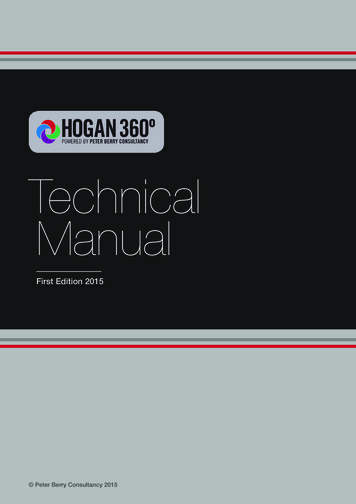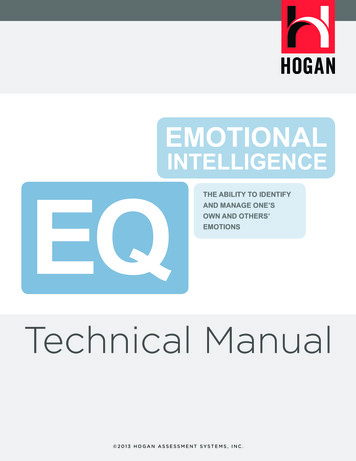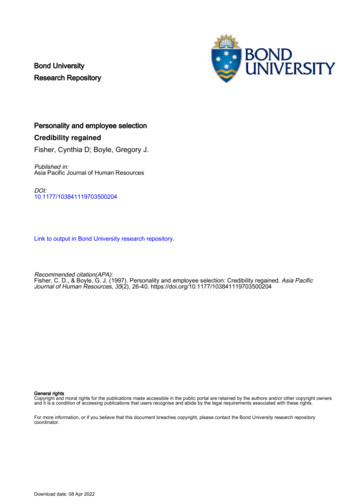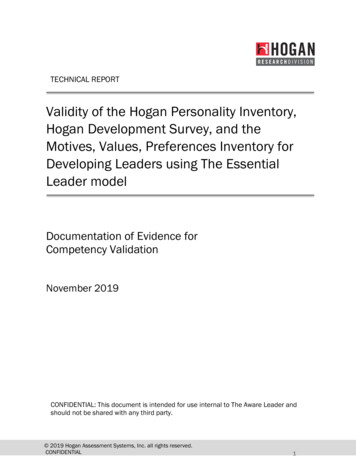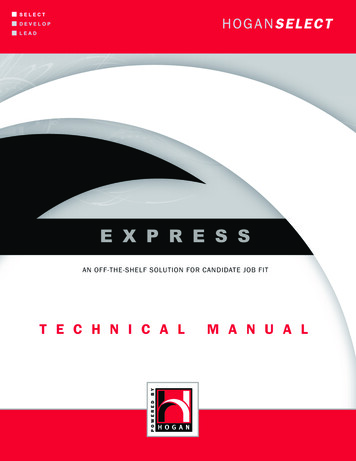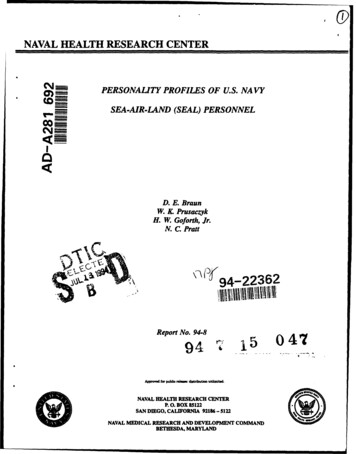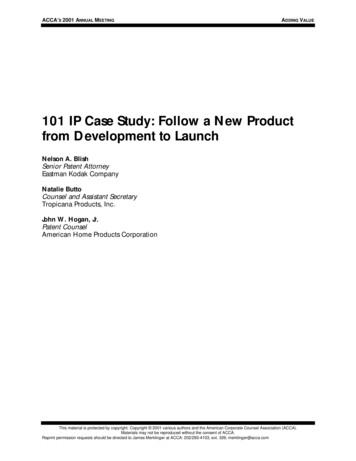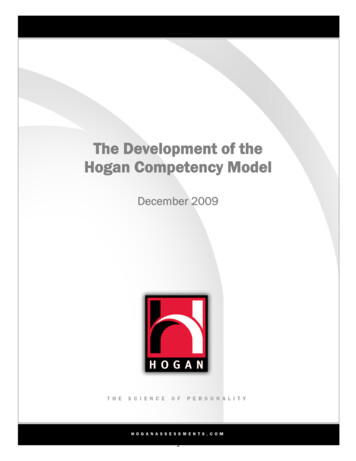
Transcription
The Development of theHogan Competency ModelDecember 20091
1 – INTRODUCTION1.1 BackgroundDuring the past three years, Hogan Assessment Systems (hereafter “Hogan”) witnessed an increasein the number of requests for competency-based reports as more organizations develop and usecompetency models. To identify relationships between commonly used competencies andpersonality, we developed the Hogan Competency Model (HCM). This model provides a foundationfor (a) updating the competency section of Hogan’s job analysis tool, the Job Evaluation tool (JET); (b)developing algorithms that drive client competency-based reports; (c) providing a structure for codingcriterion data in the Hogan archive, and (d) updating the synthetic validity evidence used for validitygeneralization (VG).This report outlines the development of the HCM and describes how the Hogan Research Division(HRD) uses the model to conduct personality-related research. The HCM has three advantages.First, we designed the model to have minimal overlap between competencies, allowing us to bettermeasure specific behaviors. Second, we designed competencies to target specific areas ofperformance. In contrast, many models target several behaviors with a single competency. This lackof specificity contaminates measurement and subsequent prediction of the competency. Finally, ourdevelopment process centered on a review of twenty-one competency models used acrossacademic, commercial, and government settings.This both assures that the model iscomprehensive and that it can be easily compared to and used in conjunction with other competencymodels.1.2 History and Development of Competency ModelingGlobal markets require organizations to simultaneously work within different locations, legalenvironments, and cultures. One strategy for facing this challenge is restructuring jobs, such asreducing management layers and relying on work teams, to increase adaptability andresponsiveness (Ashkenas, Ulrich, Jick, & Kerr, 1995; Howard, 1995; Keidel, 1994). As a result,traditional task-based job analysis procedures may lack the flexibility required to identify theknowledge, skills, and abilities essential for success in many jobs (Barnes-Nelson, 1996; Olian &Rynes, 1991; Sanchez, 1994). Therefore, organizations often use competency models to align manyof their Human Resource Management applications.The work of David McClelland (1973) set the stage for the widespread growth of competencies.McClelland argued that aptitude tests, almost universally used to predict performance, do not servetheir intended purpose well and are prone to cultural biases. Also, he argued that other traditionalmeasures, such as examination results and references, are equally poor at predicting job success.Instead, McClelland suggested that individual competence might provide a more promisingalternative for predicting performance. He described competencies as representing groups ofbehaviors underlying individual characteristics that enable superior job performance.Competencies appear in educational, training, employment, and assessment contexts, where often aprimary goal is identifying individual characteristics that lead to success (Boyatzis, Stubbs, & Taylor,2002; Rubin et al., 2007; Spencer & Spencer, 1993). Companies can link individual characteristics2
to competencies that represent critical job components. Then they can use this information to selectindividuals with these characteristics and guide development and training efforts.The 1980s witnessed a growth in using competencies to identify and predict leadershipeffectiveness and long-term success (Boyatzis, 1982; McClelland & Boyatzis, 1982). Theseapplications led to the development of high-level management and leadership competency models(Hollenbeck, McCall, & Silzer, 2006) and competency-based selection tools, such as behavioralevent interviews (Boyatzis, 1994; McClelland, 1998; Spencer, McClelland, & Spencer, 1994).Competencies also provide a structure for linking performance with cognitive ability and personality(Heinsman, de Hoogh, Koopman, & van Muijen, 2007), coaching employees to overcomedysfunctional behavior (Boyatzis, 2006), and selecting and developing high potential employees(McClelland, 1994).3
2 – DEVELOPMENT OF HOGAN COMPETENCY MODEL2.1 Competency Evaluation Tool (CET)The Competency Evaluation Tool (CET), which most recently contained items representing 56competencies, is a standard part of the JET. Although the CET has undergone several changes,ranging at times from 41 to 65 competencies, the 56-item version was in place for 5 years prior tothe changes described in this report. The CET asks Subject Matter Experts (SMEs) to indicate thedegree to which each competency relates to successful performance in the job or job family understudy. SMEs, anyone that is familiar with the job’s requirements and characteristics that lead to highperformance, typically include supervisors, high performing incumbents, and co-workers. Directreports, trainers, and customers have also served as JET SMEs. SME ratings provide a basis forstructural models used to examine comparability of job domains and their competencies across jobs(J. Hogan, Davies, & R. Hogan, 2007).Although the CET remains a useful and integral part of Hogan’s job analysis process, an increasingamount of work based on client’s competency models lead to a critical review of the most recent 56item version of the CET. We concluded that three areas needed addressed. First, some competencydefinitions required revision because they (a) included multiple concepts, (b) overlapped significantlywith other competencies, and/or (c) were unclear. Second, some competencies that company’scommonly included in their models were missing from the 56-item version of the CET. Third, therewas no underlying structure to the model. As outlined in section 2.2, we incorporated the DomainModel of performance (Hogan & Warrenfeltz, 2003; Warrenfeltz, 1995) into the HCM as the mainstructure of the taxonomy.2.2 Domain ModelResearchers can use the Domain Model to effectively classify existing competencies into acomprehensive and meaningful performance model (Hogan & Warrenfeltz, 2003; Warrenfeltz,1995), leading to easier interpretations of and comparisons across models. The Domain Modelcontains four domains: Intrapersonal Skills – Intrapersonal skills develop early in childhood and have importantconsequences for career development in adulthood. Core components include core-selfesteem, resiliency, and self-control. Intrapersonal skills form the foundation on whichcareers develop. Interpersonal Skills - Interpersonal skills concern building and sustaining relationships.Interpersonal skills can be described in terms of three components: (a) an ability to putoneself in the position of another person, (b) an ability to accurately perceive and anticipateother’s expectations, and (c) an ability to incorporate information about the other person'sexpectations into subsequent behavior. Technical Skills (work skills) - Technical skills differ from Intrapersonal and Interpersonalskills in that they are (a) the last to develop, (b) the easiest to teach, (c) the most cognitive,and (d) the least dependent upon dealing with other people. Technical skills involve4
comparing, compiling, innovating, computing, analyzing, coordinating, synthesizing, and soon. Leadership Skills - Leadership skills can be understood in terms of five components thatdepend upon intrapersonal, interpersonal, and technical skills. First, leadership skills entailan ability to recruit talented people to join the team. Second, one must be able to retaintalent once it has been recruited. Third, one must be able to motivate a team. Fourth,effective leaders are able to develop and promote a vision for the team. Finally, leadershipskill involves being persistent and hard to discourage.R. Hogan and Warrenfeltz (2003) suggest that the four domains form a natural, overlappingdevelopmental sequence, with the latter skills (e.g., Leadership Skills) depending on the appropriatedevelopment of the earlier skills (e.g., Intrapersonal Skills). Each of the performance domains canbe further decomposed into various performance dimensions or competencies. Table 2.1 outlinesthe complete domain model, illustrating the links between common competencies associated witheach domain and Five Factor Model (FFM) personality measures. Each competency in the HCM fallsunder one of the four domains.5
Table 2.1 Domain Model of Job Performance, Example Competencies, and Personality MeasuresMetaconceptDomainExample CompetencyFFM MeasurementLeadershipGetting AheadTechnicalInterpersonalGetting AlongIntrapersonalAchievementBuilding TeamsBusiness AcumenDecision MakingDelegationEmployee DevelopmentInitiativeLeadershipManaging PerformanceResource ManagementAnalysisCreating KnowledgeDecision MakingPolitical AwarenessPresentation SkillsProblem SolvingSafetyTechnical SkillTraining PerformanceWritten CommunicationBuilding RelationshipsCommunicationConsultative SkillsCooperatingInfluenceInterpersonal SkillOrganizational CitizenshipService ail OrientationFlexibilityFollowing ProceduresIntegrityPlanningRespectRisk TakingStress ToleranceWork Attitude6Surgency/ExtraversionOpenness to entiousnessEmotional Stability
2.3 Creating the HCMHRD designed the HCM to align with other well known competency models and personalitymeasures. The development of the HCM included five steps. First, we reviewed the competencydefinitions in the 56-item version of the CET, flagging competencies that measured multipleconstructs or overlapped with other competencies. Next, we reviewed 21 academic, commercial,and government competency models and compared them to the CET (see Appendix A for a list of themodels). Three HRD researchers independently mapped the original 56 competencies to eachcomparison model. Based on all available information from the first two steps, we eliminatedredundant competencies, clarified definitions, and added frequently occurring and missingcompetencies. Fourth, we obtained feedback from non-Industrial/Organizational (I/O) professionalson the revised list of competencies. Finally, four HRD researchers again independently mapped therevised competency model to each of the 21 comparison models. The resulting model included 58competencies in addition to the 4 domains. The following sections further delineate these steps.2.3.1 Competency DefinitionsWe began by examining the competencies and definitions on the 56-item version of the CET. First,HRD identified overlapping competencies by examining competency definitions and correlating CETratings obtained on a sample of over 500 jobs. Results indicated that several competenciesoverlapped both conceptually and statistically. For example, Trustworthiness and Integrityoverlapped significantly, as did Adaptability and Flexibility. Furthermore, other models often treatedthese and other pairings as one competency.Next, we reviewed competency definitions. We flagged competency definitions that (a) included thecompetency name in the definition, (b) contained multiple concepts, (c) overlapped with othercompetencies, or (d) were generally unclear. For example, Innovation was defined as “findinginnovative solutions ,” and the definition of Planning/Organizing addressed multiple concepts(resource management and time management) but not aspects of organization typically addressedby similar competencies in other models.2.3.2 Competitor and Academic Competency ModelsNext, we reviewed 21 independent competency models and compared the CET to the identifiedmodels. These models came from academic, commercial, and government sources. We identifiedcompetency models using three strategies. First, we conducted a literature search for publicationsoutlining relevant competency models (e.g. Tett, Guterman, Bleir, & Murphy, 2000). Next, wecontacted partner organizations, including clients and distributors, and asked for their competencymodels. Finally, we contacted companies and competitors with well advertised or commonly usedmodels (e.g. SHL, Bartram, 2005). We only reviewed complete models containing completecompetency definitions. Our final sample consisted of six commercial models, twelve academicmodels, and three from government agencies. Appendix A presents a complete list of the models.7
2.3.3 Competency MappingCompetency mapping consisted of three phases.Phase 1: I/O Professionals. Three HRD researchers independently mapped the CET to eachcompetency in the 21 comparison models. Raters indicated if the competencies in the other modelsmapped directly to a Hogan competency, more than one Hogan competency, or none. In addition,each rater maintained a list of frequently occurring competencies that mapped poorly to Hogancompetencies or were not included in the Hogan model. We aggregated the results and the ratersmet to resolve conflicts and reach a final consensus. Based on these final results and our previousreview of competency definitions (section 2.3.1), we eliminated redundant competencies, clarifieddefinitions, and added missing competencies.Phase 2: Non I/O Professionals. To better represent individuals who will use the model in the future,we asked four non-I/O professionals to provide feedback on the revised list of competencies. Ourgoal was to ensure that all competencies were easy for the target population to understand and use.We obtained feedback from non-I/O professionals with extensive business experience and expertisein different areas (IT, Finance, Sales, and Operations). First, each individual independently mappedeach competency into the Domain Model, noting if each competency fell under one primary domainand potentially a secondary domain. Second, they provided recommendations for the content andphrasing of the competency names and definitions. The raters successfully placed forty-three of thecompetencies into the same domain, indicating high rater agreement. Furthermore, no rater notedany problems with the competency model names and definitions, indicating that the model isintuitive and not overly laden with I/O jargon.Phase 3: Re-mapping: I/O Professionals. Finally, four HRD researchers again independently mappedthe revised competency model to each of the 21 comparison models and met to reach a finalconsensus. The number of competencies that mapped to the comparison models greatly increasedfrom phase 1. However, we found a few definitions that needed further revision and identified fouradditional competencies for inclusion. For example, because 7 of the 21 comparison modelscontained Valuing Diversity, we added it to the Hogan model. The resulting competency modelincludes 58 competencies plus names and definitions for the 4 components of the Domain Model.Appendix B presents the resulting HCM.After finalizing the model, we calculated the frequency of use for each competency across all 21comparison competency models. Appendix C presents these results. Overall, each Hogancompetency averaged 7 mappings. We mapped each model to the Hogan model a minimum ofthree times. This represents over 12,480 individual comparisons of the Hogan model to thecomparison models. This finding provides further support for the comprehensiveness of the Hoganmodel. Also, we calculated the domain use frequency. Interpersonal, Leadership, and Technicalskills contain a similar number of competencies, whereas Intrapersonal skill is the most frequentlyused domain.8
3 – USING THE HOGAN COMPETENCY MODEL3.1 Job AnalysisThe JET contains five sections. The first four align with Hogan inventories (the HPI, HDS, MVPI, andHBRI); the fifth is the Competency Evaluation Tool (CET). The CET asks SMEs to indicate the degreeto which each of the listed competencies relates to successful performance in the job or job familyunder study. Raters evaluate each competency using a five-point scale ranging from “0” (Notassociated with job performance) to “4” (Critical to job performance). Critical competencies mustreceive an average score of at least “3” (Important to performance). These ratings serve a numberof purposes, such as identifying competencies to use in synthetic validation for the HPI and HDS,showing similarities across roles in job comparison studies, determining the importance of anorganization’s existing competency model components, or serving as the foundation for creating anew competency model to represent and drive performance for a job or job family.3.2 Competency Mapping StudiesAs more companies use competency models for a variety of purposes, the need to align personalityinstruments with customized competency models continues to grow. Although competency modelsinvariably differ across organizations, similarities often exist. HRD developed the HCM to capturethese similarities by continually reviewing a wide range of existing competency models throughoutthe development process. As a result, HRD can easily map HCM competencies to the vast majorityof competencies presented in other models.During the mapping process, Hogan SMEs, consisting of expert Ph.D. and Masters-level practitioners,evaluate both competency models and indicate which HCM competencies aligned with each of theclient’s competencies. Often, client competencies are broad and align with multiple HCMcompetencies. When that is the case, HRD can combine HCM competencies to adequately alignwith the client’s model. During the mapping process, HRD resolves disagreements among SMEsthrough a group decision-making task where they discuss the disagreement(s) and come to aconsensus as to which HCM competency best aligns with the corresponding client competency.Competency mapping studies serve a number of purposes, such as identifying personality scalesthat are predictive of performance for a job or aligning CET results to verify that competencies in aclient’s existing model are important for performance. Competency mapping studies may also be thefirst step in more comprehensive studies, such as those described in sections 3.3, 3.4, and 3.5. Byfirst aligning HCM competencies with competencies in a client’s model, HRD can more effectivelyuse JET data and data in the Hogan archive to answer critical research questions.3.3 Criterion-Related ResearchAguinis, Henle, and Ostroff (2001) described criterion-related validity in terms of the relationshipbetween the predictor (e.g., HPI Scales) and some criterion measure (e.g., job performance), with thegoal of answering the basic question: how accurate are test scores in predicting criterionperformance? Criterion-related validity not only provides the most direct evidence of relationshipsbetween predictor scores and job performance, but serves as the foundation for VG studies and thedevelopment of off-the-shelf selection solutions. As such, researchers have conducted criterion-9
related validation studies using Hogan assessments on over 250 jobs and job families over the last30 years. The Hogan archive contains data and results from these studies, which cover a range ofindustries, organizations, and jobs.The Uniform Guidelines state that “evidence of the validity of a test or other selection procedure by acriterion-related validity study should consist of empirical data demonstrating that the selectionprocedure is predictive of or significantly correlated with important elements of job performance” (29C.F.R. § § 1607.5 (B)). Ratings gathered from performance rating forms serve as the mostcommonly used and often most informative source of criterion data. HRD frequently uses CETresults to inform the creation of performance rating forms for criterion-related validation studies.Specifically, we use CET ratings to identify the 10-15 most important competencies for a job or jobfamily. Then, HRD writes performance-related items for each competency, assuring thatperformance ratings gathered from criterion-related validation are both comprehensive and jobrelevant.3.4 Synthetic Validity/Job Component ValidityMossholder and Arvey (1984) defined synthetic validity as “the logical process of inferring testbattery validity from predetermined validities of the tests for basic work components” (p. 323). If weknow the key components of a job, we can review prior criterion-related studies predicting thosecomponents. We then “synthesize” the valid predictors of the key job components into anassessment battery for the new job (Balma, 1959; Lawshe, 1952). Brannick and Levine (2002)point out that synthetic validity allows us to build validity evidence from small samples with commonjob components. Although not popular at its inception, published research on synthetic validity hasbecome increasing more common (e.g., Hoffman, Holden, & Gale, 2000; Jeanneret & Strong, 2003;Johnson, Carter, Davison, & Oliver, 2001; McCloy, 1994, 2001; Scherbaum, 2005).J. Hogan, Davies, and R. Hogan (2007) outline the process Hogan uses for synthetic validity.Synthetic validation involves (a) identifying the important components of a job or jobs comprising ajob family, (b) reviewing prior research on the prediction of each component, and (c) aggregatingcorrelations across multiple studies for each component to form a test battery (Scherbaum, 2005).Because the concept of synthetic validity has evolved over 50 years, Hogan uses interchangeably theterms criteria, performance dimensions, job components, work components, competencies, anddomains of work. Thus, the competencies in the HCM serve as job components and provide astructure for coding data in the Hogan archive.The first step in synthetic validation is conducting a job analysis where SMEs identify the importantcomponents of a job. Using data in the Hogan archive, HRD developed and maintains a syntheticvalidity table that shows relationships between assessment results and each HCM competency.These results represent relationships between predictor scores and competency performance acrossorganizations, industries and jobs. The most recent update to this table occurred during the summerand fall of 2009 when HRD mapped performance results from thousands of criteria measurescollected from over 260 jobs onto the HCM competencies. HRD then conducted a series of metaanalyses (see Hunter & Schmidt, 2004) to combine results across studies. These meta-analysesprovide stable estimates of the relationships between results on both the HPI and HDS and jobperformance ratings aligned with the HCM competencies.10
3.5 Competency-Based ReportsHogan generates two types of competency-based reports. First, client-specific reports presentresults in terms of predictive scores on client competency models. HRD uses competency mappingand both local criterion-related research and archival data to create predictor scales from HPI, HDS,and MVPI results. Second, off-the-shelf competency-based reports, such as the Safety report andthe High Potential report, present predictor scores on competency models that are specific to areasof performance but generalize across jobs. For example, safety is an important component of manyjobs. Hogan developed a Safety Competency model containing six dimensions that representdifferent components of safe behavior. HRD then used archival data to create predictor scales foreach dimension from HPI results.3.6 ConclusionsCompetency models have several advantages. First, when coupled with job analysis, the use ofcompetencies ensures that organizations focus on job relevant behaviors. This both increases thepredictive accuracy of a selection system and minimizes legal risk. Second, competency-basedreports present personality assessment results using language that is familiar to the client. Third,they allow organizations to streamline their selection process by focusing on competencies that (a)are often assessed using other selection instruments, thereby increasing the predictive accuracy ofthe overall selection system by assessing competencies through multiple methods; and (b) areimportant for a number of jobs, thereby allowing the organization to determine an applicant’s fit withmultiple jobs at once. Finally, they allow organizations to streamline interventions with existingemployees, such as development/training efforts and performance assessment across departmentsand functions.The HCM represents a significant improvement in Hogan’s ability to provide clients with effective andeasy to use competency based solutions. These solutions allow clients to align personalityassessment results with other organizational interventions aimed at hiring successful employees anddeveloping existing employees. HRD developed the HCM using a unique and elaborate process toensure that the model (a) comprehensively covers that majority of behaviors required for successacross organizations, industries, and jobs; (b) easily maps onto the majority of competencies inexisting models; and (c) can be used to produce results that are both easy to use and understand.11
ReferencesAguinis, H., Henle, C.A., & Ostroff, C. (2001). Measurement in work and organizationalpsychology. In N. Anderson, D.S. Ones, H.K. Sinangil, and C. Viswesvaran (Eds.),Handbook of Industrial, Work and Organizational Psychology, (Vol. 1, pp. 27-50).London, U.K.Ashkenas, R., Ulrich, D., Jick, T., & Kerr, S. (1995). Actions for global learners, launchers,and leaders. In R. N. Ashkenas, D. Ulrich, T. Jick, & S. Kerr (Eds.), The boundarylessorganization: Breaking the chains of organizational structure (pp. 293-324). SanFrancisco: Jossey-Bass.Balma, M. J. (1959). The development of processes for indirect or synthetic validity. PersonnelPsychology, 12, 395-396.Barnes-Nelson, J. (1996). The boundaryless organization: Implications for job analysis, recruitment,and selection. Human Resource Planning, 20, 39-49.Bartram, D. (2005). The Great Eight Competencies: A Criterion-Centric Approach to Validation.Journal of Applied Psychology, 90(6), 1185-1203.Boyatzis, R.E. (1982). The Competent Manager: A Model for Effective Performance. New York, NY:Wiley.Boyatzis, R.E. (1994). Rendering unto competence the things that are competent.Psychologist, 49, 64-66.AmericanBoyatzis, R.E. (2006). Core competencies in coaching others to overcome dysfunctional behavior. InR.E. Boyatzis, Linking Emotional Intelligence and Performance at Work: Current ResearchEvidence with Individuals and Groups. Mahwah, NJ: Lawrence Erlbaum AssociatesPublishers.Boyatzis, R.E., Stubbs, E.C., & Taylor, S.N. (2002). Learning cognitive and emotional intelligencecompetencies through graduate management education. Academy of ManagementLearning and Education, 1, 150-162.Equal Employment Opportunity Commission (1978). Uniform guidelines on employee selectionprocedures. Federal Register, 43, 38,290-38,315.Brannick, M. T., & Levine, E. L. (2002). Doing a job analysis study. In Job analysis: Methods,research, and applications for human resource management in the new millennium (pp.265-294). Thousand Oaks, CA: Sage.Heinsman, H., de Hoogh, A.H.B., Koopman, P.L., & van Muijen, J.J. (2007). Competencies throughthe eyes of psychologists: A closer look at assessing competencies. International Journal ofSelection and Assessment, 15, 412-427.12
Hoffman, C. C., Holden, L. M., & Gale, E. (2000). So many jobs, so little “n”: Applying expandedvalidation models to support generalization of cognitive ability. Personnel Psychology, 53,955–991.Hogan, J., Davies, S., & Hogan, R. (2007). Generalizing personality-based validity evidence. In S. M.McPhail (Ed.), Alternative validation strategies (pp. 181-229). San Francisco: Jossey-Bass.Hogan, R., & Warrenfeltz, W. (2003). Educating the modern manager. Academy of ManagementLearning and Education, 2, 74-84.Hollenbeck, G.P., McCall, M.W., & Silzer, R.F. (2006). Leadership competency models. LeadershipQuarterly, 17, 398-413.Howard, A. (1995). The changing nature of work. San Francisco: Jossey-Bass.Hunter, J. E., and Schmidt, F. L. (2004). Methods of meta-analysis: correcting error and bias inresearch findings. Thousand Oaks, CA: Sage Publications.Jeanneret, P. R., & Strong, M. H. (2003). Linking O*NET job analysis information to job requirementpredictors: An O*NET application. Personnel Psychology, 56, 465-492.Johnson, J. W., Carter, G. W., Davison, H. K., & Oliver, D. H. (2001). A synthetic validity approach totesting differential prediction hypotheses. Journal of Applied Psychology, 86, 774-780.Keidel, R.W. (1994). Rethinking organizational design. The Academy of Management Executive, 8,12-30.Lawshe, C. H. (1952). What can industrial psychology do for small business? (A symposium).Personnel Psychology, 5, 31-34.McClelland, D.C. (1973). Testing for competence rather than for “intelligence.”Psychologist, 28, 1-14.AmericanMcClelland, D.C. (1994). The knowledge-testing-educational complex strikes back.Psychologist, 49, 66-69.AmericanMcClelland, D.C. (1998). Identifying competencies with behavioral-event interviews. PsychologicalScience, 9, 331-339.McClelland, D.C., & Boyatzis, R.E. (1982). Leadership motive pattern and long-term success inmanagement. Journal of Applied Psychology, 67, 737-743.McCloy, R. A. (1994). Predicting job performance scores without performance data. In B. F. Green &A. S. Mavor (Eds.), Modeling cost and performance for military enlistment: Report of aworkshop. Washington, DC: National Academy Press.McCloy, R. A. (2001, April). Predicting job performance scores in jobs lacking criterion data. In J.Johnson & G. Carter (Chairs), Advances in the application of synthetic validity. Symposium13
conducted at the 16th Annual Conference of the Society for Industrial and OrganizationalPsychology, San Diego, CA.Mossholder, K. W., & Arvey, R. D. (1984). Synthetic validity: A conceptual and comparative review.Journal of Applied Psychology, 69, 322-333.Olian, J.D., & Rynes, S.L. (1991). Making total quality work: Aligning organizational processes,p
The Competency Evaluation Tool (CET), which most recently contained items representing 56 competencies, is a standard part of the JET. Although the CET has undergone several changes, ranging at times from 41 to 65 competencies, the 56-item version was in place for 5 years prior to
